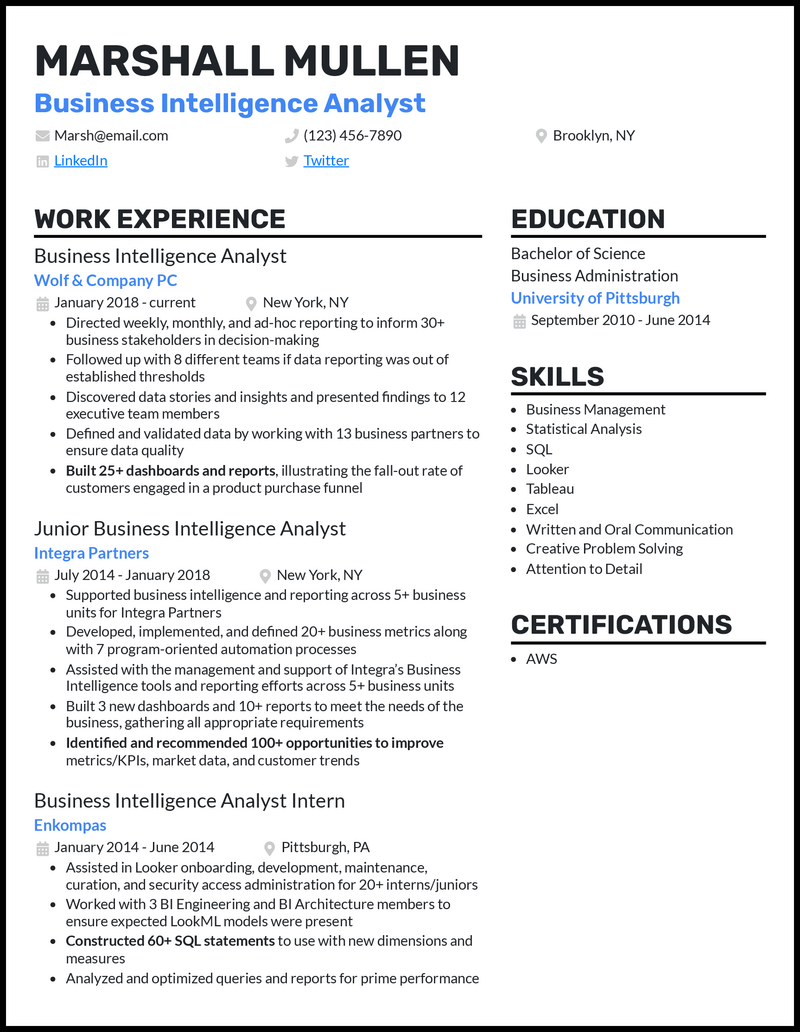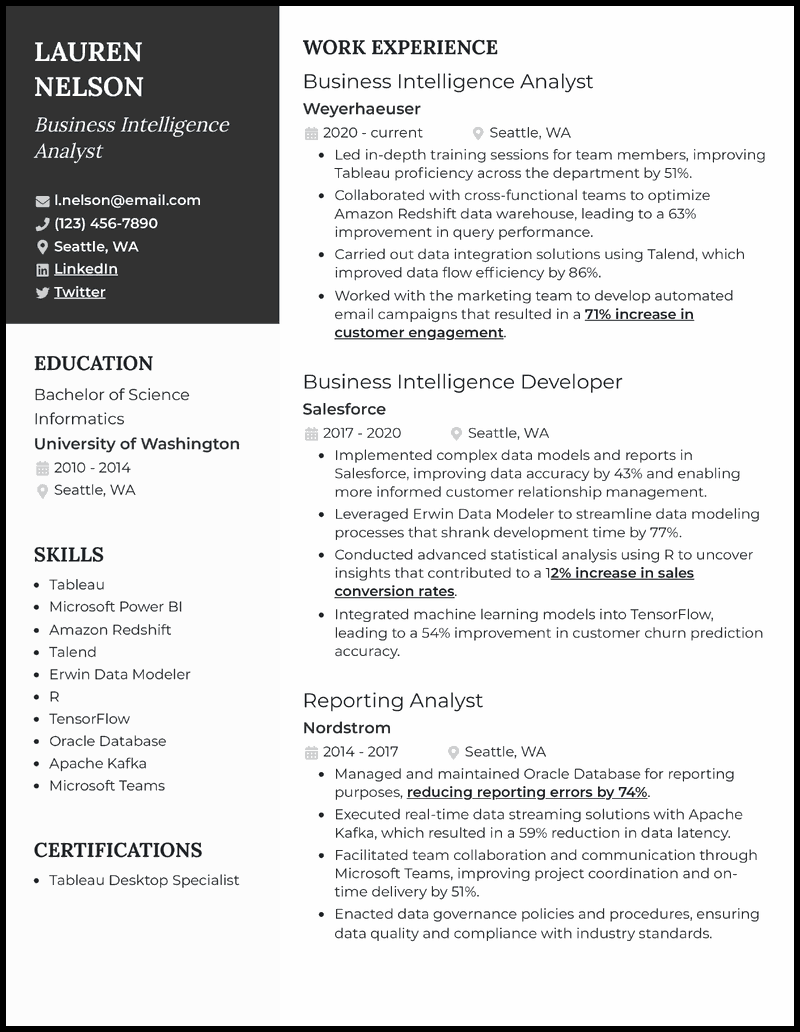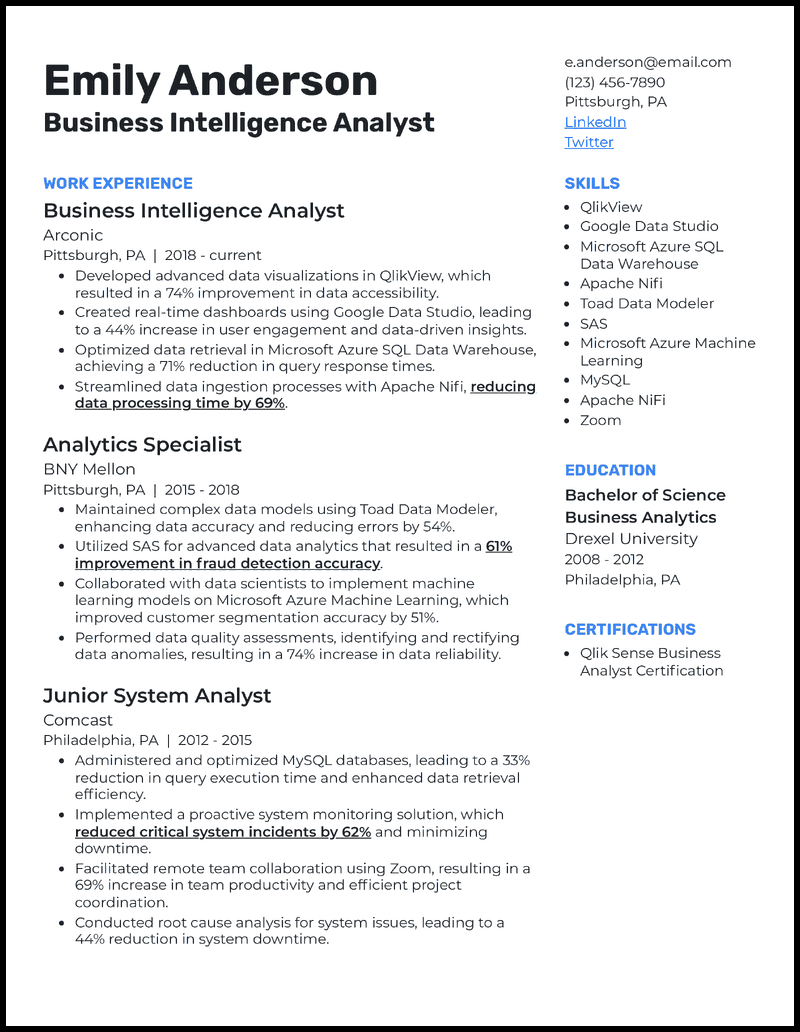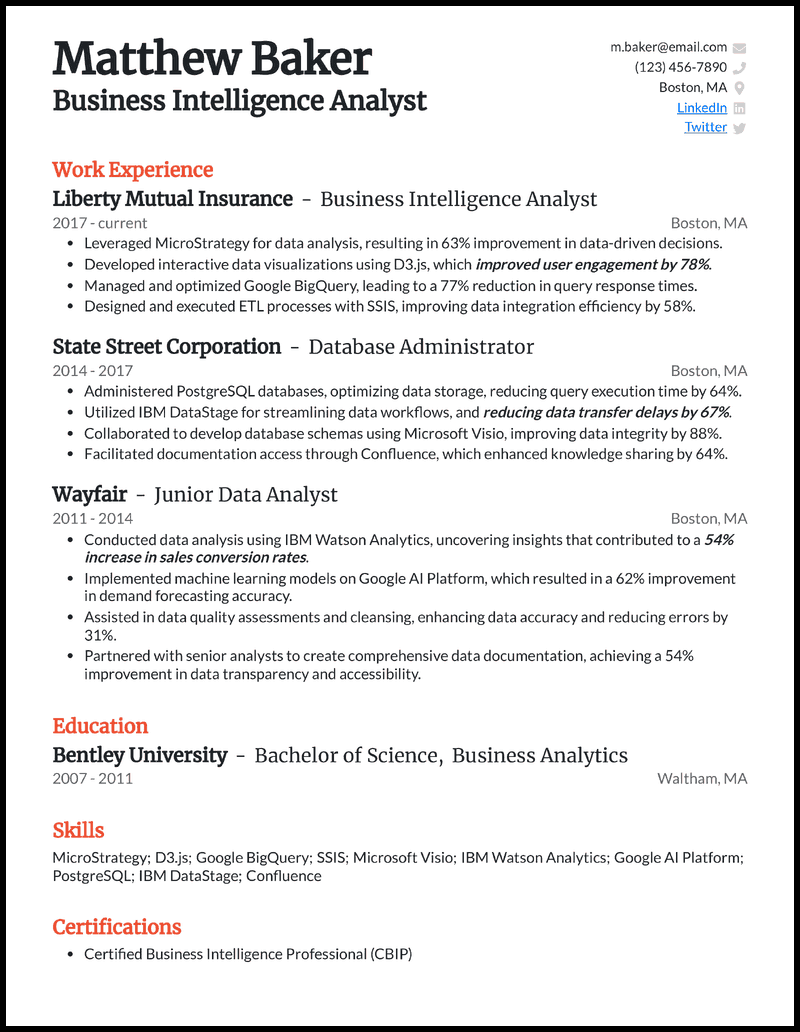Landing a top role as a business intelligence analyst starts with a resume that clearly blends technical expertise with strategic insight.
This guide breaks down what to include—from essential soft and hard skills to how to structure it using a smart resume builder—so you can stand out in a crowded market.
What you’ll find inside:
- ↪ 15 real-world business intelligence analyst resume examples to learn from and adapt
- ↪ A practical path to getting hired in your dream field—from resume tips to interview prep
- ↪ What hiring managers really want to see, and how to showcase your skills with clarity and impact
Why this resume works
- You’re whipping up a business intelligence analyst resume, hoping it could open doors at premier firms. And you’ve dotted your i’s and crossed your t’s with all the essentials—think experiences, skills, and certifications. However, skip adding that glam shot of yourself, even if you think it’s particularly flattering.
How to Write a Business Intelligence Analyst Resume

Writing a standout business intelligence analyst resume means translating data-driven impact into clear, results-focused language.
Summary
✅Use the perfect format for business intelligence analysts
✅Put your data analytical skills at the forefront
✅Spotlight your most impactful achievements
✅Package relevant education and certification to make you stand out
✅Tailor for the role you’re going for
This section breaks down exactly what to include so your skills and story align with what top employers are actively searching for.
What to include:
- Technical and analytical skills that match the role—SQL, Power BI, Tableau, Python
- Real achievements that show how your insights led to smarter decisions or saved money
- Work experience that highlights collaboration, problem-solving, and business impact
- Education and certifications that reinforce your qualifications (think: CBIP, Google Data Analytics)
- Tools, industries, and projects that reflect your niche or specialization
- Any extras—presentations, dashboards, stakeholder reports—that show real-world results

The core components of a business intelligence analyst resume
See your resume as a value snapshot that gives executives quick, actionable insight—clear, tightly written, and focused on the results you’ve delivered.
Don’t make it all about your tech skills; connect those skills to real business outcomes.
Key elements to include:
- A focused professional summary that shows your career highlights
- A layout that’s easy to read and ATS-friendly
- A skills section that reflects your technical toolkit (SQL, Tableau, Power BI, Python, etc.)
- Accomplishments backed by data and numbers
- Relevant education, training, or certifications
Every section should confirm one thing: you know how to turn raw information into business value.

Grab attention with the right resume header
Your header is the handshake of your resume—it sets the first impression. Go beyond the basics (name, title, and contact information) by adding a professional headline that captures your focus area.
Always use a professional email address, and if possible, include a link to your LinkedIn profile or portfolio of dashboards. That small detail shows you take your career branding seriously.

Lead with your data analytics skills
When recruiters check out your AI cover letter and resume, they first want to see you have the required data analytics skills. They know their most pressing business intelligence needs and want to know if you can meet those needs.
The hiring team will jump directly to your “skills” section to determine this. Here is where your resume will go into the “no” pile if they don’t believe you have the minimum qualifications for the job.
It’s best to focus on the top two to three data analytics skills you have that align with what the company is seeking based on the job description.
9 top business intelligence analyst skills
- Data analysis
- Data security
- Data visualization
- Data prep & reporting
- BI strategic planning
- Stakeholder partnership
- Keen finance acumen
- Descriptive analytics
- Statistical analysis

Pakc your experience bullet points with impactful achievements
As a business intelligence analyst, you have many hard skills to highlight on your resume. This is good news. Your job, then, is to emphasize how those hard skills improved a company’s business intelligence efforts and bottom line.
Highlight the different areas of business intelligence analysis you’ve touched on and discuss your role in meeting the needs of department heads and business users.
Provide context for the types of data you gathered, analyzed, and cleaned, and the business areas of focus, then describe your impact. Offer up as much quantifiable data as possible that shows your impact vs. simply describing your job responsibilities.
Here are a few ideas from our sample resumes:
- Defined and analyzed 30+ data points for monthly supply chain cost reports that supported the development of cost-cutting efforts, saving the company $100K annually while improving supply chain efficiency by 3%
- Developed, implemented, and defined 20+ business metrics along with seven program-oriented automation processes, which improved data reporting efficiency by 7% and reduced procurement costs by 4%
- Constructed 60+ SQL statements to use with new dimensions and measures to replace antiquated reporting measures and improve data retrieval capability
- Built 25+ BI dashboards and reports that illustrated the fall-out rate of customers engaged in a product purchase funnel, leading to the implementation of process improvement strategies that reduced fall-out by 11% over six months

Demonstrate how your transform data to actionable intelligence
Recruiters don’t want to see a laundry list of tools—they want to know how you use them. Replace flat statements like “created reports in Power BI” with achievement-driven bullets.
Example
Designed a Power BI dashboard that cut customer churn by 12% within six months.
Use strong verbs such as analyzed, automated, visualized, predicted, or optimized. Walk readers through how you gather, process, and translate data into insights that executives or teams can act on. This turns your resume from technical jargon into proof of business impact.

Establish authority with relevant training and certifications
Certifications may not guarantee you a role, but they reinforce credibility and help you clear ATS filters. If you hold credentials like CBIP, Google Data Analytics, or Tableau Specialist, showcase them in a prominent spot.
Also highlight ongoing professional development—whether in programming, cloud tools, or advanced analytics. This signals that you’re committed to staying current in a fast-moving field.

Emphasize your record in solving real business problems
Responsibilities describe what you were supposed to do. Results show what you actually achieved. Employers care most about the latter.
Examples of impact-driven bullets:
- Automated reporting processes in Power BI, cutting delivery time by 34% and improving data accuracy across teams
- Unlocked $2M in new revenue opportunities by segmenting untapped customer groups using SQL
- Built predictive models in Python with 98% accuracy, guiding key leadership decisions and shaping long-term strategy
Frame each bullet point around outcomes that connect directly to business goals. Numbers, percentages, and dollar figures make your contributions tangible.

Tailor your draft to the specific role and industry
No two BI analyst roles are identical. A resume targeting financial services firm won’t necessarily fit a healthcare provider or logistics company. Customization is what makes the difference.
Before sending your resume, ask yourself:
- Which KPIs matter most in this role?
- Does the posting highlight specific platforms or industry tools?
- Is the employer looking for someone deeply technical, or someone focused on strategy?
Use specific keywords and mirror the language of the job description and highlight the experience most relevant to that industry. Doing this shows attention to detail and helps recruiters see you as a natural fit.
Top 5 tips for your business intelligence analyst resume
- Data ownership and expertise are key
- You’re being hired to help the business improve its metrics, like revenue, profits, cost reduction, and customer engagement. Focus on and make your work experience bullet points showcase your high level of data ownership and expertise to improve these business metrics.
- It’s all about the numbers
- Quantifiable data shows the recruiter what you can do. It provides a story of your impact and allows them to visualize how those accomplishments will help you succeed on the job. For example, reduction in cost by 5%, increase in productivity by 8%, and streamlining and consolidating five reports into a single report for easier data assimilation.
- Be specific about your business intelligence experience
- No one individual being hired is expected to know everything in their field of expertise. So, for your resume, be specific and highlight where you truly stand out in your field to capture a recruiter’s attention, like the time you caught an error in reporting to reduce costs by $10K in a quarter or identified process improvement to boost sales by 11% over two quarters.
- Tailor your resume for each job application
- If the company mentions in its job listing that it needs descriptive analytics expertise, but your resume only mentions statistical analysis, you may be out of luck. Customization should only take 10 to 15 minutes per application, and it’s well worth your time, since it lets the company know you’ve done your homework.
- Showcase your ability to communicate effectively
- As a business intelligence analyst, you regularly communicate your findings with business leaders and users. Showcase your ability to effectively communicate your insights and conclusions to remove any questions about this capability.

Key takeaways
- Open with a strong header that defines your focus and direction
- Prove that you turn data into actionable insight, not just charts and tables
- Use certifications and training to strengthen credibility
- Back up your experience with measurable business results
- Customize every application so it matches the role and industry directly
Business Intelligence Analyst Resume FAQs

If you include a career objective, you want to tailor it for each application you submit. It should consist of a few critical skills with your years of experience and goal.
For example: “Resourceful and insightful professional with over seven years of experience as a business intelligence analyst, providing me with excellent analytical, technical, and communication skills. Eager to thrive in KeyLogic Systems’s flexible and fast-paced environment to achieve and exceed client goals and expectations.”
The best format for a business intelligence analyst resume is reverse-chronological. Your internships and entry-level BA roles help set the foundation for your career and should be at the bottom, so your most recent and most relevant work can be at the top of the page, where it’s easy for the reader to see.
Certifications can fall under their own category or be included under your resume’s education section. If you choose the latter, list your certifications below your degrees, such as Microsoft Certified: Power BI Data Analyst Associate or Certified Business Intelligence Professional.




















